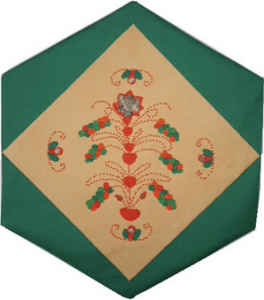Wendat

The Block
Husband and wife team, Jean-Marie and Hélène Gros-Louis combined their talents to make the Wendat block. Using traditional beading techniques learned as a child, Hélène brought the Wendat tree-of-life (resembling a Canadian balsam) to artistic life with vivid shades of red, orange and green. This form of decorative motif was found on clothing throughout the 19th century and is experiencing a resurgence in popularity. Hélène’s work includes tufted moose hair, a complex practice unique to the Wendat. The design is set on a background made of tanned deer hide contributed by Jean-Marie, whose skills in hunting and trapping came to him through his ancestors.
Cultural Profile
Known also as Hurons, a name given to them by French traders, the Wendat originated from the Lake Simcoe/Georgian Bay region of Ontario. The Wendat were actually a group of four nations organized politically into a confederacy or league. Their name means “islanders” or “peninsula dwellers.” The Wendat, whose Huron language is now extinct, speak Iroquoian.
During their earlier history, the Wendat had a monopoly on corn and tobacco, which they traded for furs with other Aboriginal nations. The Wendat used trees, such as the Canadian balsam, to build dugout canoes and massive longhouses averaging 40 to 50 feet in length by 30 feet high. The Canadian balsam symbolized the people’s strength. It stood as a poerful reminder of their connection to nature and their ancestral homeland, Wendake, on Georgian Bay in Ontario. In 1649, severely diminished by disease and war, the original members of the Huron Confederacy, had dispersed. Many became refugees and joined other First Nations groups. One group eventually settled in Quebec near Lorette, establishing a community called Wendake.
Centuries later in 1999, hundreds of Wendat descendents returned to their homeland in Central Ontario. They gathered to inter the remains of 500 ancestors, removed from a sacred burial ground and held at the Royal Ontario Museum for decades. The occasion was marked by a traditional celebration called the Feast of the Dead.
Today, Wendat descendants are located in the Lake Simcoe/Georgian Bay region of Ontario, in eastern and central Québec, as well as Oklahoma and Kansas. Those living amongst other First Nations still recall their ancestral heritage. There are approximately 2,750 Wendat, many of whom work in the tourist, cultural, services and manufacturing sectors (making snowshoes, moccasins and canoes, among other products).
Sponsor: Martintown Goodtimers
